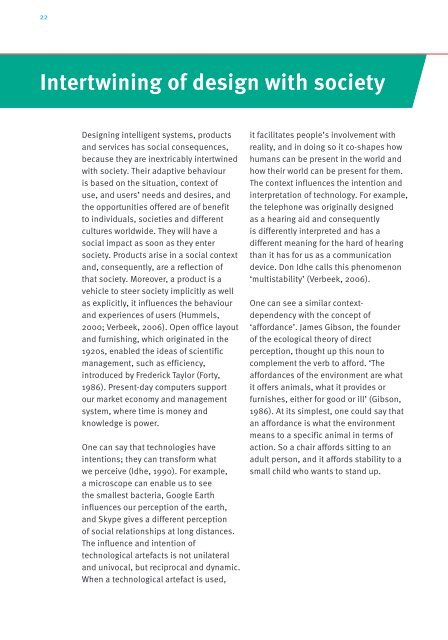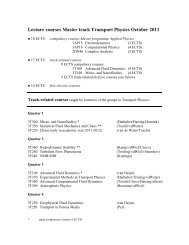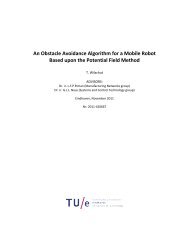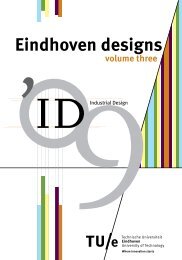Education guide 'Eindhoven designs' - Technische Universiteit ...
Education guide 'Eindhoven designs' - Technische Universiteit ...
Education guide 'Eindhoven designs' - Technische Universiteit ...
Create successful ePaper yourself
Turn your PDF publications into a flip-book with our unique Google optimized e-Paper software.
22<br />
Intertwining of design with society<br />
Designing intelligent systems, products<br />
and services has social consequences,<br />
because they are inextricably intertwined<br />
with society. Their adaptive behaviour<br />
is based on the situation, context of<br />
use, and users’ needs and desires, and<br />
the opportunities offered are of benefit<br />
to individuals, societies and different<br />
cultures worldwide. They will have a<br />
social impact as soon as they enter<br />
society. Products arise in a social context<br />
and, consequently, are a reflection of<br />
that society. Moreover, a product is a<br />
vehicle to steer society implicitly as well<br />
as explicitly, it influences the behaviour<br />
and experiences of users (Hummels,<br />
2000; Verbeek, 2006). Open office layout<br />
and furnishing, which originated in the<br />
1920s, enabled the ideas of scientific<br />
management, such as efficiency,<br />
introduced by Frederick Taylor (Forty,<br />
1986). Present-day computers support<br />
our market economy and management<br />
system, where time is money and<br />
knowledge is power.<br />
One can say that technologies have<br />
intentions; they can transform what<br />
we perceive (Idhe, 1990). For example,<br />
a microscope can enable us to see<br />
the smallest bacteria, Google Earth<br />
influences our perception of the earth,<br />
and Skype gives a different perception<br />
of social relationships at long distances.<br />
The influence and intention of<br />
technological artefacts is not unilateral<br />
and univocal, but reciprocal and dynamic.<br />
When a technological artefact is used,<br />
it facilitates people’s involvement with<br />
reality, and in doing so it co-shapes how<br />
humans can be present in the world and<br />
how their world can be present for them.<br />
The context influences the intention and<br />
interpretation of technology. For example,<br />
the telephone was originally designed<br />
as a hearing aid and consequently<br />
is differently interpreted and has a<br />
different meaning for the hard of hearing<br />
than it has for us as a communication<br />
device. Don Idhe calls this phenomenon<br />
‘multistability’ (Verbeek, 2006).<br />
One can see a similar contextdependency<br />
with the concept of<br />
‘affordance’. James Gibson, the founder<br />
of the ecological theory of direct<br />
perception, thought up this noun to<br />
complement the verb to afford. ‘The<br />
affordances of the environment are what<br />
it offers animals, what it provides or<br />
furnishes, either for good or ill’ (Gibson,<br />
1986). At its simplest, one could say that<br />
an affordance is what the environment<br />
means to a specific animal in terms of<br />
action. So a chair affords sitting to an<br />
adult person, and it affords stability to a<br />
small child who wants to stand up.

















